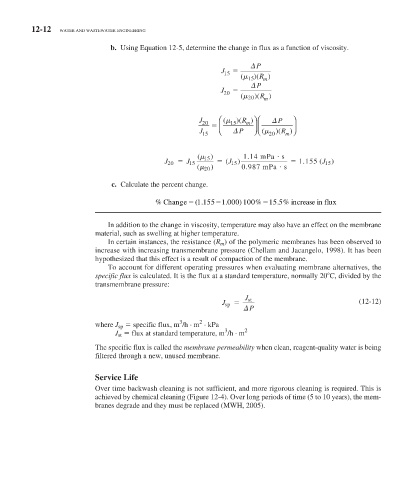Page 495 - Water and wastewater engineering
P. 495
12-12 WATER AND WASTEWATER ENGINEERING
b. Using Equation 12-5, determine the change in flux as a function of viscosity.
P
J 15
( )(R m )
15
P
J 20
( 20 )(R m )
J 20 ⎛ ( 15 )( R )⎞ ⎛ P ⎞
m
⎟
⎠ ⎝
J ⎜ ⎝ P ⎟ ⎜ )( R )⎠
15 ( 20 m
15 ) 114 mPa s
.
J 20 J 15 ( ( J 15 ) 1155 (J 15 )
.
20 ) . a
( 0 987 mPa s
c. Calculate the percent change.
.
% Change (1155 1 000 100 % 155 % increase iin flux
)
.
.
In addition to the change in viscosity, temperature may also have an effect on the membrane
material, such as swelling at higher temperature.
In certain instances, the resistance ( R m ) of the polymeric membranes has been observed to
increase with increasing transmembrane pressure (Chellam and Jacangelo, 1998). It has been
hypothesized that this effect is a result of compaction of the membrane.
To account for different operating pressures when evaluating membrane alternatives, the
specific flux is calculated. It is the flux at a standard temperature, normally 20 C, divided by the
transmembrane pressure:
J st
J sp (12-12)
P
2
3
where J sp specific flux, m /h · m · kPa
2
3
J st flux at standard temperature, m /h · m
The specific flux is called the membrane permeability when clean, reagent-quality water is being
filtered through a new, unused membrane.
Service Life
Over time backwash cleaning is not sufficient, and more rigorous cleaning is required. This is
achieved by chemical cleaning ( Figure 12-4 ). Over long periods of time (5 to 10 years), the mem-
branes degrade and they must be replaced (MWH, 2005).

